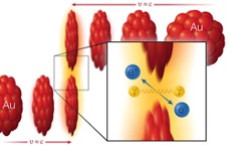Matter & Antimatter Creation from Real Photon Interactions
July 27, 2021

Making matter from light: Two gold (Au) ions (red) move in opposite direction at 99.995% of the speed of light (v, for velocity, = approximately c, the speed of light). As the ions pass one another without colliding, two photons (γ) from the electromagnetic cloud surrounding the ions can interact with each other to create a matter-antimatter pair: an electron (e-) and positron (e+). Image: Brookhaven National Laboratory
Science Achievement
Scientists have produced definitive evidence for a phenomenon predicted more than 80 years ago: the creation of electron/positron pairs from the interaction of two real photons of light The results are based on a detailed analysis of data from the Relativistic Heavy Ion Collider (RHIC) at Brookhaven National Laboratory.
Significance and Impact
The finding that pairs of electrons and positrons — particles of matter and antimatter — can be created directly from two interacting real photons had never been observed. The team’s new analysis, backed by better statistics and updated theoretical calculations, shows this effect arising from photon interactions associated with close approaches of energetic gold ions produced at RHIC.
Research Details
The results were derived from a detailed analysis of more than 6,000 pairs of electrons and positrons produced in glancing particle collisions. These measurements utilized NERSC resources to establish data corrections extracted by embedding simulated data into real data, a process that STAR runs routinely at NERSC.
Related Links
Adam, J. et al ; STAR Collaboration, "Measurement of e(+)e(-) Momentum and Angular Distributions from Linearly Polarized Photon Collisions"; Physical Review Letters, 127 2021 JUL 27, 10.1103/PhysRevLett.127.052302
About NERSC and Berkeley Lab
The National Energy Research Scientific Computing Center (NERSC) is a U.S. Department of Energy Office of Science User Facility that serves as the primary high performance computing center for scientific research sponsored by the Office of Science. Located at Lawrence Berkeley National Laboratory, NERSC serves almost 10,000 scientists at national laboratories and universities researching a wide range of problems in climate, fusion energy, materials science, physics, chemistry, computational biology, and other disciplines. Berkeley Lab is a DOE national laboratory located in Berkeley, California. It conducts unclassified scientific research and is managed by the University of California for the U.S. Department of Energy. »Learn more about computing sciences at Berkeley Lab.







